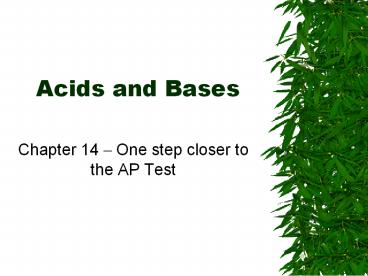Acids and Bases PowerPoint PPT Presentation
1 / 18
Title: Acids and Bases
1
Acids and Bases
- Chapter 14 One step closer to the AP Test
2
- Arrhenius Definition
- Acids produce hydrogen ions in aqueous solution.
- Bases produce hydroxide ions when dissolved in
water. - Limits to aqueous solutions.
- Only one kind of base.
- NH3 ammonia could not be an Arrhenius base.
3
Bronsted-Lowry Definitions
- And acid is an proton (H) donor and a base is a
proton acceptor. - Acids and bases always come in pairs.
- HCl is an acid.
- When it dissolves in water it gives its proton to
water. - HCl(g) H Cl-
- Water is a base -makes hydronium ion
4
What do all of these have in common?
- NH3 H2O CO32-
5
Dissociate the Following
- 1. Hydrochloric acid
- 2. Acetic acid
- 3. Ammonium ion
- 4. Anilinium ion (C6H5NH3)
- 5. Hydrate Aluminum (III) ion Al(H2O)63
- 1. HCl H Cl-
- 2. HC2H3O2 H C2H3O2-
- 3. NH4 H NH3
- 4. C6H5NH3 H C6H5NH2
- 5. Al(H2O)63 H
Al(H2O)5OH2
6
Polyprotic Acid
- Be careful dissociating polyprotic acids.
- H2SO4 H HSO4- SA
- HSO4- H SO42- WA
- H3PO4 H H2PO4- WA
7
Pairs
- General equation
- HA(aq) H2O(l) H3O(aq) A-(aq)
- Acid Base Conjugate acid Conjugate
base - This is an equilibrium.
- Competition for H between H2O and A-
- The stronger base controls direction.
- If H2O is a stronger base it takes the H
- Equilibrium moves to right.
8
Writing Net Ionic A-B Reactions
1- Determine if the species are an acid, base or
salt 2 Determine if the acid or base are strong
or weak If SA or SB dissociate completely
(Show with an ) If WA or WB it
reaches equilibrium (Show with an
) 3. If a salt, determine if either ion is
reactive (Comes from a WA or WB) Determine
whether the reactive ion acts as an acid or base
(What type
of solution is it in) Write the reaction of
the ion. 4. Write the neutralizations reaction 5.
Cross out SA, SB and Salt reactions 6. Add the
remaining reactions together
9
Lets try one together
- Equimolar amounts of hydrochloric acid and
potassium hydroxide are mixed. - HCl H Cl- SA
- KOH K OH- SB
- H OH- H2O
- H OH- H2O
10
Another example
- 0.1M nitrous acid solution is added to the same
volume of a 0.1M sodium hydroxide solution. - (Equimolar amounts H2O MUST be a product)
- HNO2 H NO2- wa
- NaOH Na OH- sb
- H OH- H2O
- HNO2 OH- H2O NO2-
11
Example 2
- A solution of potassium hydroxide is added to a
solution of ammonium chloride. - KOH K OH- SB
- NH4Cl NH4 Cl- salt
- NH4 NH3 H
- H OH- H2O
- NH4 OH- NH3 H2O
12
Example 3
- Dilute acetic acid solution is added to solid
magnesium carbonate. - HC2H3O2 H C2H3O2- wa
- MgCO3 Mg2 CO32- salt
- CO32- H2O HCO3- OH-
- H OH- H2O
- HC2H3O2 CO32- HCO3- C2H3O2-
13
And yet another onefrom the WS
- Solutions of ammonia and hydrofluoric acid are
mixed. - NH3 H2O NH4 OH- wb
- HF H F- wa
- H OH- H2O
- NH3 HF NH4 F-
14
Problem 2
- Hydrogen sulfide has is bubbled through a
solution of potassium hydroxide. - H2S H HS- wa
- KOH K OH- sb
- H OH- H2O
- H2S OH- H2O HS-
15
Problem 3 A twist
- A solution of sulfuric acid is added to a
solution of barium hydroxide until the same
number of moles of each compound has been added. - H2SO4 H HSO4- sa
- Ba(OH)2 Ba2 2OH- sb
- H OH- H2O
- Ba2 SO42- H OH- H2O
BaSO4
16
Problem 4
- A solution of sodium hydroxide is added to a
solution of sodium dihydrogen phosphate until the
same number of moles of each compound has been
added. - NaOH Na OH- sb
- NaH2PO4 Na H2PO4- salt
- H2PO4- H HPO42-
- H OH- H2O
- H2PO4- OH- H2O HPO42-
17
Problem 5
- Dilute nitric acid is added to crystals of pure
calcium oxide. - HNO3 H NO3- sa
- CaO H2O Ca2 2OH-
- 2H 2OH- 2H2O
- CaO 2H Ca2 H2O
18
Jump to Problem 8
- Excess sulfur dioxide gas is bubbles through a
dilute solution of potassium hydroxide. - KOH K OH- sb
- SO2 (NMO H2O) HSO3-
- HSO3- H SO32-
- H OH- H2O
- SO2 OH- H2O SO32-

